Reflective Report: Exploring Design Thinking in Entrepreneurship
VerifiedAdded on 2023/06/04
|10
|3203
|171
Report
AI Summary
This reflective report chronicles a student's journey through a Design Thinking course, exploring its impact on their aspirations to become a businessman. The report delves into the core concepts of design thinking, including empathy, iterative processes, and user-centered design, as well as the skills of timekeeping, teamwork, and organization. The student reflects on various theories, such as the left-right brain theory, and practical activities, including brainstorming and journey mapping, that enhanced their understanding of design thinking principles. The report highlights the importance of creativity, innovation, and a designer's mindset in the context of entrepreneurship. The student also discusses the application of design thinking to real-world business scenarios, drawing insights from successful innovators and the need for flexibility in the dynamic business environment. The report concludes with the student's personal reflections on the course's impact on their thinking, the applicability of design thinking, and their future career aspirations.
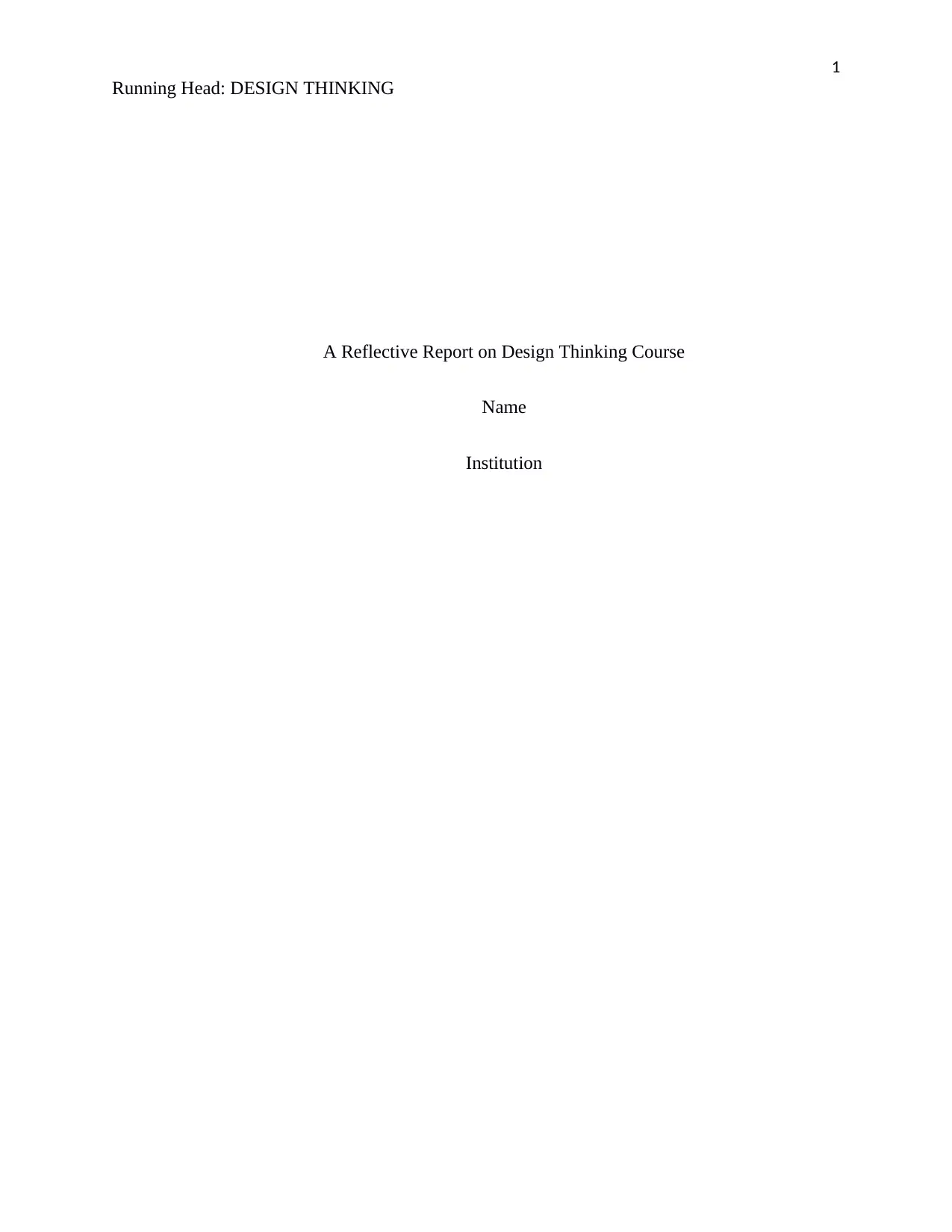
1
Running Head: DESIGN THINKING
A Reflective Report on Design Thinking Course
Name
Institution
Running Head: DESIGN THINKING
A Reflective Report on Design Thinking Course
Name
Institution
Paraphrase This Document
Need a fresh take? Get an instant paraphrase of this document with our AI Paraphraser
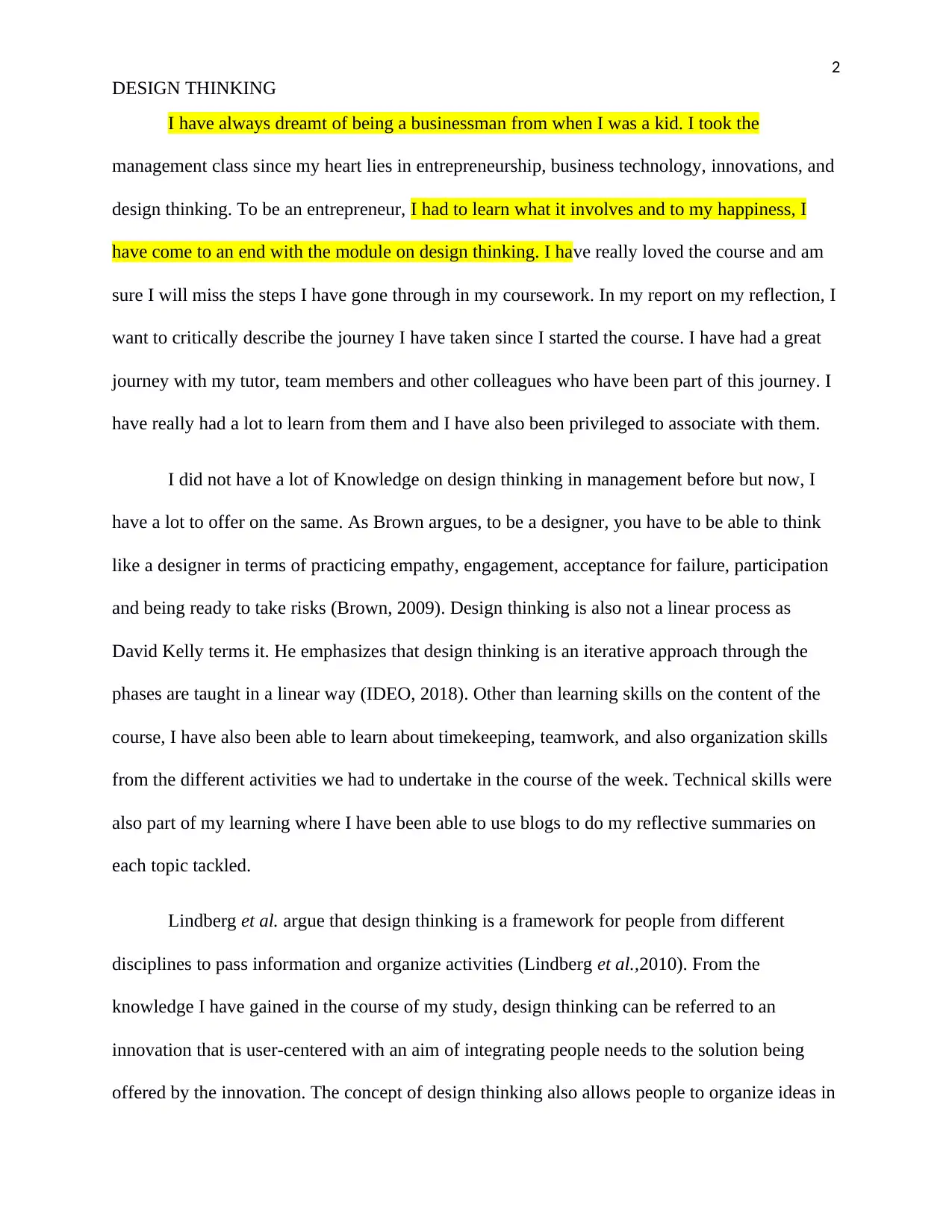
2
DESIGN THINKING
I have always dreamt of being a businessman from when I was a kid. I took the
management class since my heart lies in entrepreneurship, business technology, innovations, and
design thinking. To be an entrepreneur, I had to learn what it involves and to my happiness, I
have come to an end with the module on design thinking. I have really loved the course and am
sure I will miss the steps I have gone through in my coursework. In my report on my reflection, I
want to critically describe the journey I have taken since I started the course. I have had a great
journey with my tutor, team members and other colleagues who have been part of this journey. I
have really had a lot to learn from them and I have also been privileged to associate with them.
I did not have a lot of Knowledge on design thinking in management before but now, I
have a lot to offer on the same. As Brown argues, to be a designer, you have to be able to think
like a designer in terms of practicing empathy, engagement, acceptance for failure, participation
and being ready to take risks (Brown, 2009). Design thinking is also not a linear process as
David Kelly terms it. He emphasizes that design thinking is an iterative approach through the
phases are taught in a linear way (IDEO, 2018). Other than learning skills on the content of the
course, I have also been able to learn about timekeeping, teamwork, and also organization skills
from the different activities we had to undertake in the course of the week. Technical skills were
also part of my learning where I have been able to use blogs to do my reflective summaries on
each topic tackled.
Lindberg et al. argue that design thinking is a framework for people from different
disciplines to pass information and organize activities (Lindberg et al.,2010). From the
knowledge I have gained in the course of my study, design thinking can be referred to an
innovation that is user-centered with an aim of integrating people needs to the solution being
offered by the innovation. The concept of design thinking also allows people to organize ideas in
DESIGN THINKING
I have always dreamt of being a businessman from when I was a kid. I took the
management class since my heart lies in entrepreneurship, business technology, innovations, and
design thinking. To be an entrepreneur, I had to learn what it involves and to my happiness, I
have come to an end with the module on design thinking. I have really loved the course and am
sure I will miss the steps I have gone through in my coursework. In my report on my reflection, I
want to critically describe the journey I have taken since I started the course. I have had a great
journey with my tutor, team members and other colleagues who have been part of this journey. I
have really had a lot to learn from them and I have also been privileged to associate with them.
I did not have a lot of Knowledge on design thinking in management before but now, I
have a lot to offer on the same. As Brown argues, to be a designer, you have to be able to think
like a designer in terms of practicing empathy, engagement, acceptance for failure, participation
and being ready to take risks (Brown, 2009). Design thinking is also not a linear process as
David Kelly terms it. He emphasizes that design thinking is an iterative approach through the
phases are taught in a linear way (IDEO, 2018). Other than learning skills on the content of the
course, I have also been able to learn about timekeeping, teamwork, and also organization skills
from the different activities we had to undertake in the course of the week. Technical skills were
also part of my learning where I have been able to use blogs to do my reflective summaries on
each topic tackled.
Lindberg et al. argue that design thinking is a framework for people from different
disciplines to pass information and organize activities (Lindberg et al.,2010). From the
knowledge I have gained in the course of my study, design thinking can be referred to an
innovation that is user-centered with an aim of integrating people needs to the solution being
offered by the innovation. The concept of design thinking also allows people to organize ideas in
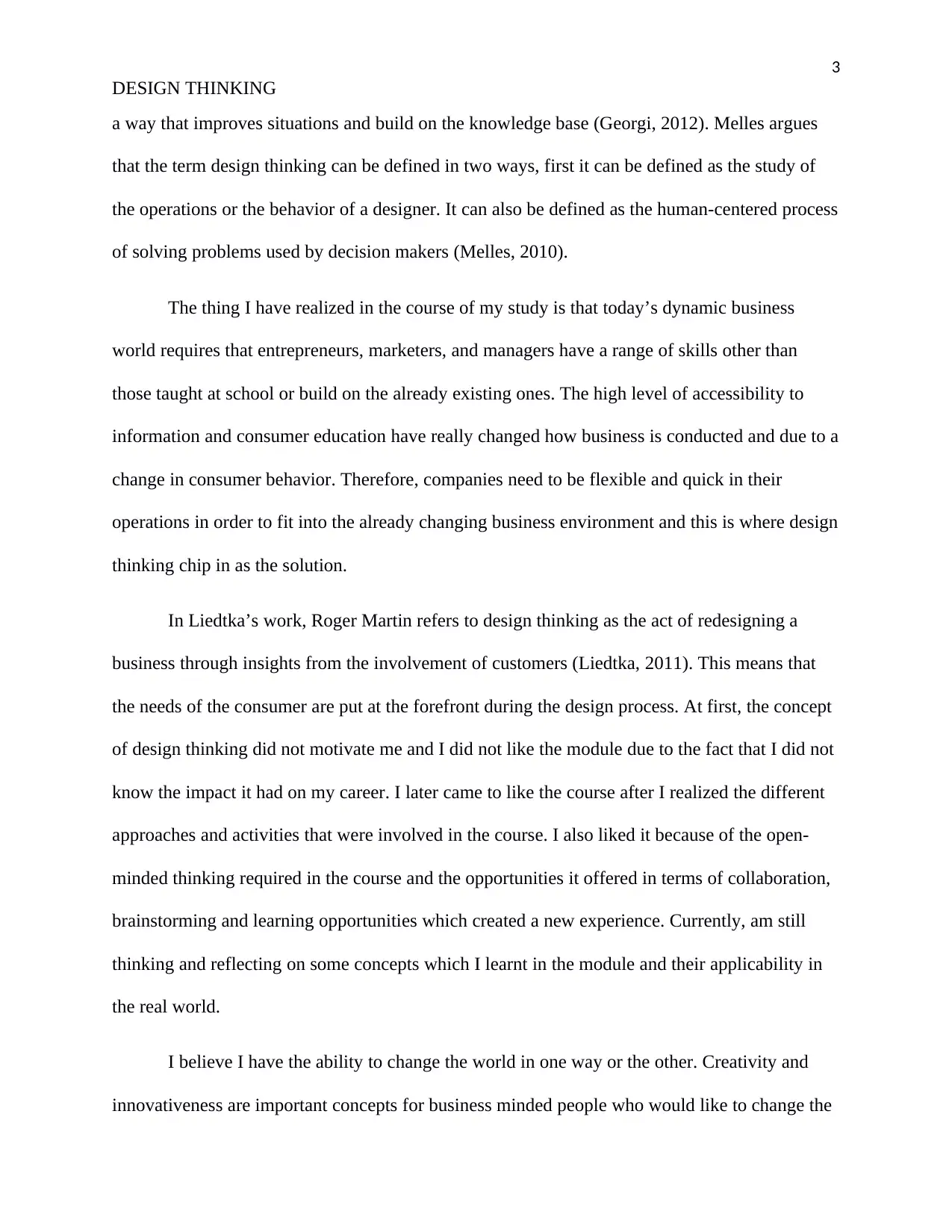
3
DESIGN THINKING
a way that improves situations and build on the knowledge base (Georgi, 2012). Melles argues
that the term design thinking can be defined in two ways, first it can be defined as the study of
the operations or the behavior of a designer. It can also be defined as the human-centered process
of solving problems used by decision makers (Melles, 2010).
The thing I have realized in the course of my study is that today’s dynamic business
world requires that entrepreneurs, marketers, and managers have a range of skills other than
those taught at school or build on the already existing ones. The high level of accessibility to
information and consumer education have really changed how business is conducted and due to a
change in consumer behavior. Therefore, companies need to be flexible and quick in their
operations in order to fit into the already changing business environment and this is where design
thinking chip in as the solution.
In Liedtka’s work, Roger Martin refers to design thinking as the act of redesigning a
business through insights from the involvement of customers (Liedtka, 2011). This means that
the needs of the consumer are put at the forefront during the design process. At first, the concept
of design thinking did not motivate me and I did not like the module due to the fact that I did not
know the impact it had on my career. I later came to like the course after I realized the different
approaches and activities that were involved in the course. I also liked it because of the open-
minded thinking required in the course and the opportunities it offered in terms of collaboration,
brainstorming and learning opportunities which created a new experience. Currently, am still
thinking and reflecting on some concepts which I learnt in the module and their applicability in
the real world.
I believe I have the ability to change the world in one way or the other. Creativity and
innovativeness are important concepts for business minded people who would like to change the
DESIGN THINKING
a way that improves situations and build on the knowledge base (Georgi, 2012). Melles argues
that the term design thinking can be defined in two ways, first it can be defined as the study of
the operations or the behavior of a designer. It can also be defined as the human-centered process
of solving problems used by decision makers (Melles, 2010).
The thing I have realized in the course of my study is that today’s dynamic business
world requires that entrepreneurs, marketers, and managers have a range of skills other than
those taught at school or build on the already existing ones. The high level of accessibility to
information and consumer education have really changed how business is conducted and due to a
change in consumer behavior. Therefore, companies need to be flexible and quick in their
operations in order to fit into the already changing business environment and this is where design
thinking chip in as the solution.
In Liedtka’s work, Roger Martin refers to design thinking as the act of redesigning a
business through insights from the involvement of customers (Liedtka, 2011). This means that
the needs of the consumer are put at the forefront during the design process. At first, the concept
of design thinking did not motivate me and I did not like the module due to the fact that I did not
know the impact it had on my career. I later came to like the course after I realized the different
approaches and activities that were involved in the course. I also liked it because of the open-
minded thinking required in the course and the opportunities it offered in terms of collaboration,
brainstorming and learning opportunities which created a new experience. Currently, am still
thinking and reflecting on some concepts which I learnt in the module and their applicability in
the real world.
I believe I have the ability to change the world in one way or the other. Creativity and
innovativeness are important concepts for business minded people who would like to change the
⊘ This is a preview!⊘
Do you want full access?
Subscribe today to unlock all pages.

Trusted by 1+ million students worldwide
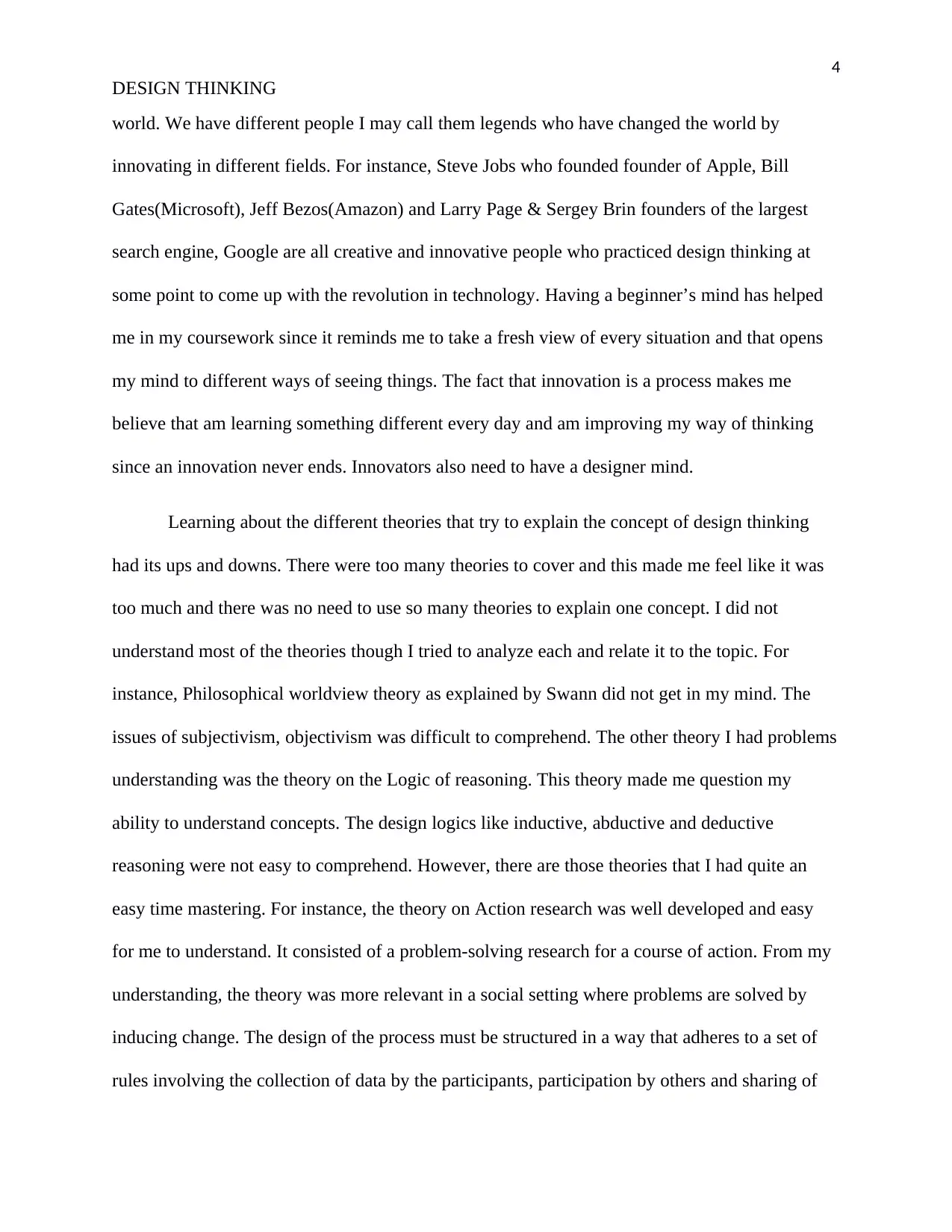
4
DESIGN THINKING
world. We have different people I may call them legends who have changed the world by
innovating in different fields. For instance, Steve Jobs who founded founder of Apple, Bill
Gates(Microsoft), Jeff Bezos(Amazon) and Larry Page & Sergey Brin founders of the largest
search engine, Google are all creative and innovative people who practiced design thinking at
some point to come up with the revolution in technology. Having a beginner’s mind has helped
me in my coursework since it reminds me to take a fresh view of every situation and that opens
my mind to different ways of seeing things. The fact that innovation is a process makes me
believe that am learning something different every day and am improving my way of thinking
since an innovation never ends. Innovators also need to have a designer mind.
Learning about the different theories that try to explain the concept of design thinking
had its ups and downs. There were too many theories to cover and this made me feel like it was
too much and there was no need to use so many theories to explain one concept. I did not
understand most of the theories though I tried to analyze each and relate it to the topic. For
instance, Philosophical worldview theory as explained by Swann did not get in my mind. The
issues of subjectivism, objectivism was difficult to comprehend. The other theory I had problems
understanding was the theory on the Logic of reasoning. This theory made me question my
ability to understand concepts. The design logics like inductive, abductive and deductive
reasoning were not easy to comprehend. However, there are those theories that I had quite an
easy time mastering. For instance, the theory on Action research was well developed and easy
for me to understand. It consisted of a problem-solving research for a course of action. From my
understanding, the theory was more relevant in a social setting where problems are solved by
inducing change. The design of the process must be structured in a way that adheres to a set of
rules involving the collection of data by the participants, participation by others and sharing of
DESIGN THINKING
world. We have different people I may call them legends who have changed the world by
innovating in different fields. For instance, Steve Jobs who founded founder of Apple, Bill
Gates(Microsoft), Jeff Bezos(Amazon) and Larry Page & Sergey Brin founders of the largest
search engine, Google are all creative and innovative people who practiced design thinking at
some point to come up with the revolution in technology. Having a beginner’s mind has helped
me in my coursework since it reminds me to take a fresh view of every situation and that opens
my mind to different ways of seeing things. The fact that innovation is a process makes me
believe that am learning something different every day and am improving my way of thinking
since an innovation never ends. Innovators also need to have a designer mind.
Learning about the different theories that try to explain the concept of design thinking
had its ups and downs. There were too many theories to cover and this made me feel like it was
too much and there was no need to use so many theories to explain one concept. I did not
understand most of the theories though I tried to analyze each and relate it to the topic. For
instance, Philosophical worldview theory as explained by Swann did not get in my mind. The
issues of subjectivism, objectivism was difficult to comprehend. The other theory I had problems
understanding was the theory on the Logic of reasoning. This theory made me question my
ability to understand concepts. The design logics like inductive, abductive and deductive
reasoning were not easy to comprehend. However, there are those theories that I had quite an
easy time mastering. For instance, the theory on Action research was well developed and easy
for me to understand. It consisted of a problem-solving research for a course of action. From my
understanding, the theory was more relevant in a social setting where problems are solved by
inducing change. The design of the process must be structured in a way that adheres to a set of
rules involving the collection of data by the participants, participation by others and sharing of
Paraphrase This Document
Need a fresh take? Get an instant paraphrase of this document with our AI Paraphraser
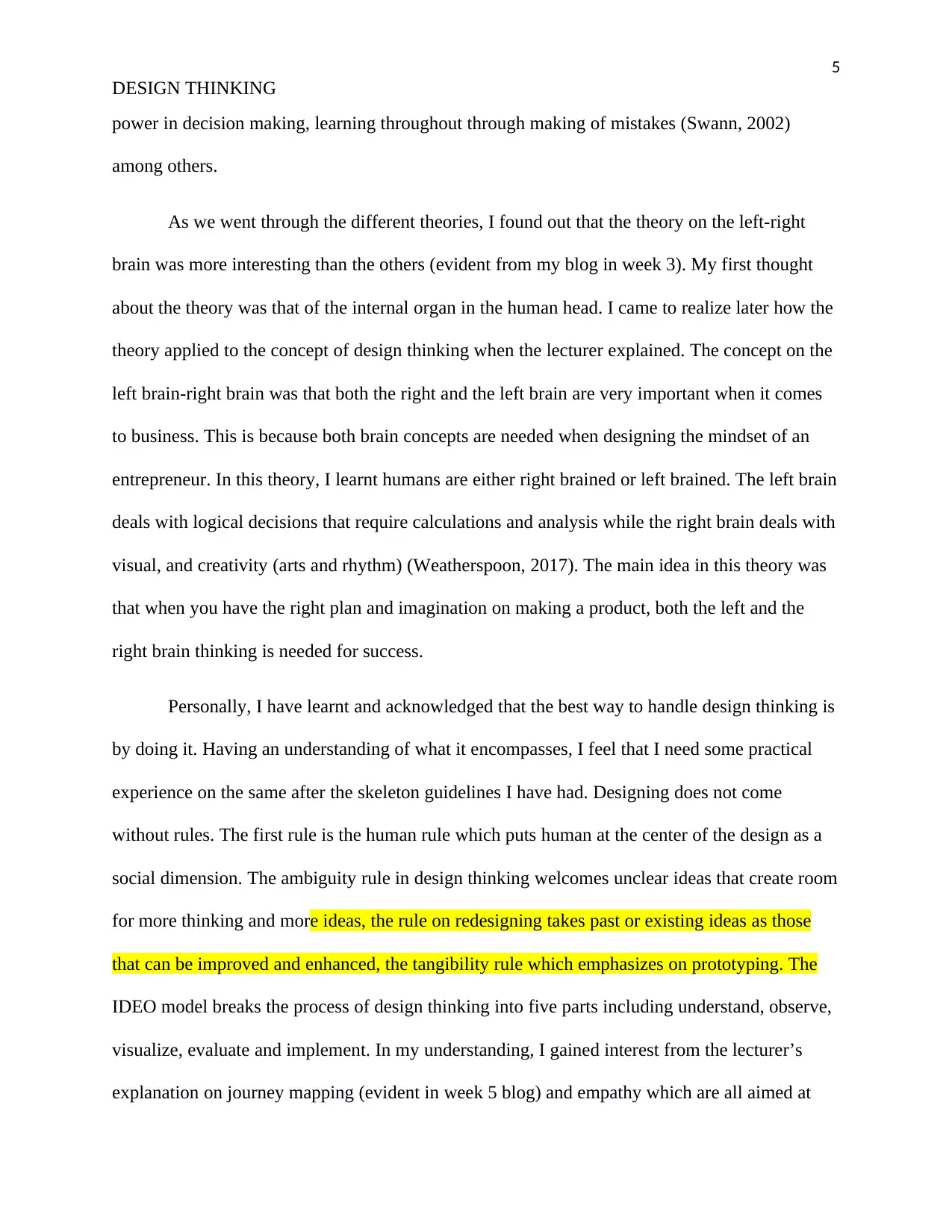
5
DESIGN THINKING
power in decision making, learning throughout through making of mistakes (Swann, 2002)
among others.
As we went through the different theories, I found out that the theory on the left-right
brain was more interesting than the others (evident from my blog in week 3). My first thought
about the theory was that of the internal organ in the human head. I came to realize later how the
theory applied to the concept of design thinking when the lecturer explained. The concept on the
left brain-right brain was that both the right and the left brain are very important when it comes
to business. This is because both brain concepts are needed when designing the mindset of an
entrepreneur. In this theory, I learnt humans are either right brained or left brained. The left brain
deals with logical decisions that require calculations and analysis while the right brain deals with
visual, and creativity (arts and rhythm) (Weatherspoon, 2017). The main idea in this theory was
that when you have the right plan and imagination on making a product, both the left and the
right brain thinking is needed for success.
Personally, I have learnt and acknowledged that the best way to handle design thinking is
by doing it. Having an understanding of what it encompasses, I feel that I need some practical
experience on the same after the skeleton guidelines I have had. Designing does not come
without rules. The first rule is the human rule which puts human at the center of the design as a
social dimension. The ambiguity rule in design thinking welcomes unclear ideas that create room
for more thinking and more ideas, the rule on redesigning takes past or existing ideas as those
that can be improved and enhanced, the tangibility rule which emphasizes on prototyping. The
IDEO model breaks the process of design thinking into five parts including understand, observe,
visualize, evaluate and implement. In my understanding, I gained interest from the lecturer’s
explanation on journey mapping (evident in week 5 blog) and empathy which are all aimed at
DESIGN THINKING
power in decision making, learning throughout through making of mistakes (Swann, 2002)
among others.
As we went through the different theories, I found out that the theory on the left-right
brain was more interesting than the others (evident from my blog in week 3). My first thought
about the theory was that of the internal organ in the human head. I came to realize later how the
theory applied to the concept of design thinking when the lecturer explained. The concept on the
left brain-right brain was that both the right and the left brain are very important when it comes
to business. This is because both brain concepts are needed when designing the mindset of an
entrepreneur. In this theory, I learnt humans are either right brained or left brained. The left brain
deals with logical decisions that require calculations and analysis while the right brain deals with
visual, and creativity (arts and rhythm) (Weatherspoon, 2017). The main idea in this theory was
that when you have the right plan and imagination on making a product, both the left and the
right brain thinking is needed for success.
Personally, I have learnt and acknowledged that the best way to handle design thinking is
by doing it. Having an understanding of what it encompasses, I feel that I need some practical
experience on the same after the skeleton guidelines I have had. Designing does not come
without rules. The first rule is the human rule which puts human at the center of the design as a
social dimension. The ambiguity rule in design thinking welcomes unclear ideas that create room
for more thinking and more ideas, the rule on redesigning takes past or existing ideas as those
that can be improved and enhanced, the tangibility rule which emphasizes on prototyping. The
IDEO model breaks the process of design thinking into five parts including understand, observe,
visualize, evaluate and implement. In my understanding, I gained interest from the lecturer’s
explanation on journey mapping (evident in week 5 blog) and empathy which are all aimed at
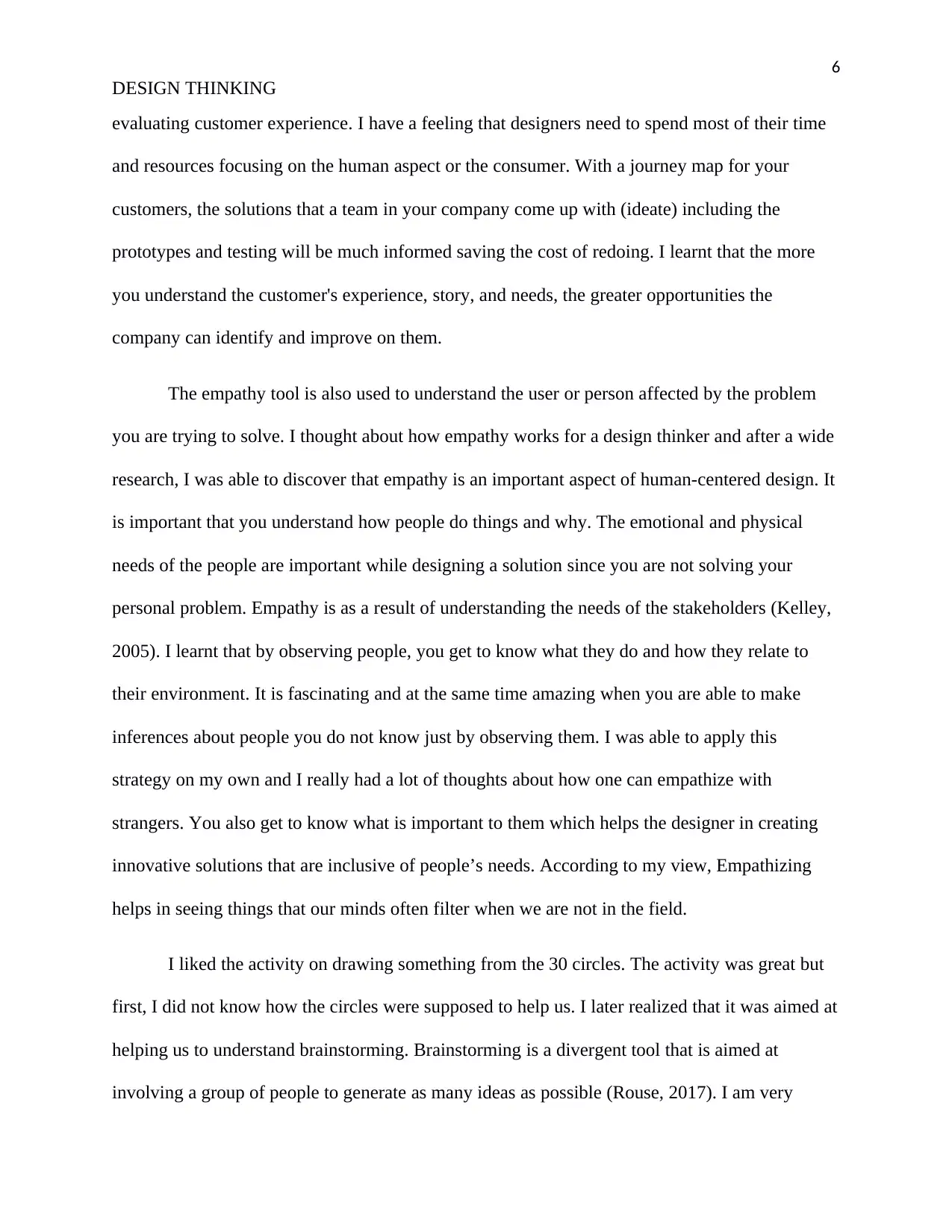
6
DESIGN THINKING
evaluating customer experience. I have a feeling that designers need to spend most of their time
and resources focusing on the human aspect or the consumer. With a journey map for your
customers, the solutions that a team in your company come up with (ideate) including the
prototypes and testing will be much informed saving the cost of redoing. I learnt that the more
you understand the customer's experience, story, and needs, the greater opportunities the
company can identify and improve on them.
The empathy tool is also used to understand the user or person affected by the problem
you are trying to solve. I thought about how empathy works for a design thinker and after a wide
research, I was able to discover that empathy is an important aspect of human-centered design. It
is important that you understand how people do things and why. The emotional and physical
needs of the people are important while designing a solution since you are not solving your
personal problem. Empathy is as a result of understanding the needs of the stakeholders (Kelley,
2005). I learnt that by observing people, you get to know what they do and how they relate to
their environment. It is fascinating and at the same time amazing when you are able to make
inferences about people you do not know just by observing them. I was able to apply this
strategy on my own and I really had a lot of thoughts about how one can empathize with
strangers. You also get to know what is important to them which helps the designer in creating
innovative solutions that are inclusive of people’s needs. According to my view, Empathizing
helps in seeing things that our minds often filter when we are not in the field.
I liked the activity on drawing something from the 30 circles. The activity was great but
first, I did not know how the circles were supposed to help us. I later realized that it was aimed at
helping us to understand brainstorming. Brainstorming is a divergent tool that is aimed at
involving a group of people to generate as many ideas as possible (Rouse, 2017). I am very
DESIGN THINKING
evaluating customer experience. I have a feeling that designers need to spend most of their time
and resources focusing on the human aspect or the consumer. With a journey map for your
customers, the solutions that a team in your company come up with (ideate) including the
prototypes and testing will be much informed saving the cost of redoing. I learnt that the more
you understand the customer's experience, story, and needs, the greater opportunities the
company can identify and improve on them.
The empathy tool is also used to understand the user or person affected by the problem
you are trying to solve. I thought about how empathy works for a design thinker and after a wide
research, I was able to discover that empathy is an important aspect of human-centered design. It
is important that you understand how people do things and why. The emotional and physical
needs of the people are important while designing a solution since you are not solving your
personal problem. Empathy is as a result of understanding the needs of the stakeholders (Kelley,
2005). I learnt that by observing people, you get to know what they do and how they relate to
their environment. It is fascinating and at the same time amazing when you are able to make
inferences about people you do not know just by observing them. I was able to apply this
strategy on my own and I really had a lot of thoughts about how one can empathize with
strangers. You also get to know what is important to them which helps the designer in creating
innovative solutions that are inclusive of people’s needs. According to my view, Empathizing
helps in seeing things that our minds often filter when we are not in the field.
I liked the activity on drawing something from the 30 circles. The activity was great but
first, I did not know how the circles were supposed to help us. I later realized that it was aimed at
helping us to understand brainstorming. Brainstorming is a divergent tool that is aimed at
involving a group of people to generate as many ideas as possible (Rouse, 2017). I am very
⊘ This is a preview!⊘
Do you want full access?
Subscribe today to unlock all pages.

Trusted by 1+ million students worldwide
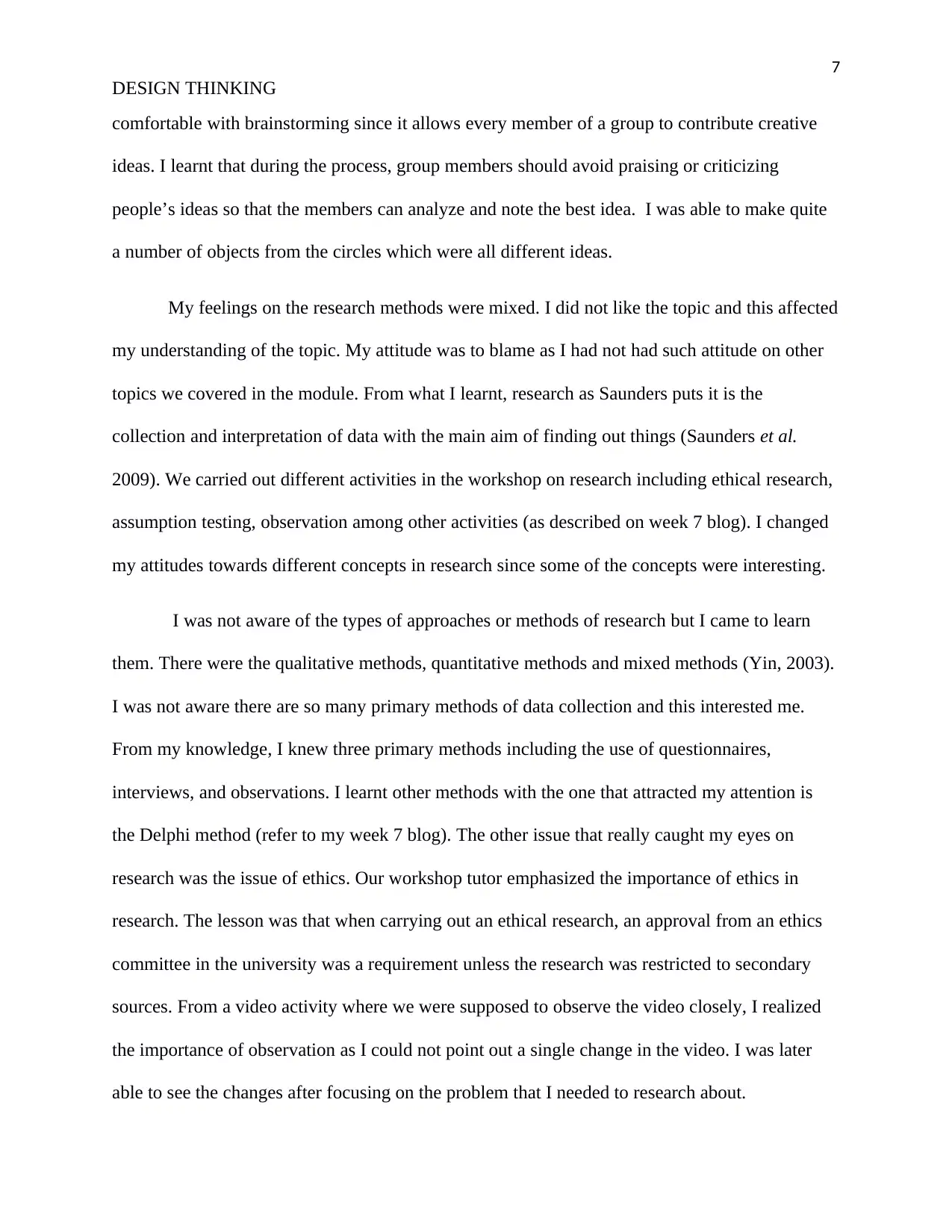
7
DESIGN THINKING
comfortable with brainstorming since it allows every member of a group to contribute creative
ideas. I learnt that during the process, group members should avoid praising or criticizing
people’s ideas so that the members can analyze and note the best idea. I was able to make quite
a number of objects from the circles which were all different ideas.
My feelings on the research methods were mixed. I did not like the topic and this affected
my understanding of the topic. My attitude was to blame as I had not had such attitude on other
topics we covered in the module. From what I learnt, research as Saunders puts it is the
collection and interpretation of data with the main aim of finding out things (Saunders et al.
2009). We carried out different activities in the workshop on research including ethical research,
assumption testing, observation among other activities (as described on week 7 blog). I changed
my attitudes towards different concepts in research since some of the concepts were interesting.
I was not aware of the types of approaches or methods of research but I came to learn
them. There were the qualitative methods, quantitative methods and mixed methods (Yin, 2003).
I was not aware there are so many primary methods of data collection and this interested me.
From my knowledge, I knew three primary methods including the use of questionnaires,
interviews, and observations. I learnt other methods with the one that attracted my attention is
the Delphi method (refer to my week 7 blog). The other issue that really caught my eyes on
research was the issue of ethics. Our workshop tutor emphasized the importance of ethics in
research. The lesson was that when carrying out an ethical research, an approval from an ethics
committee in the university was a requirement unless the research was restricted to secondary
sources. From a video activity where we were supposed to observe the video closely, I realized
the importance of observation as I could not point out a single change in the video. I was later
able to see the changes after focusing on the problem that I needed to research about.
DESIGN THINKING
comfortable with brainstorming since it allows every member of a group to contribute creative
ideas. I learnt that during the process, group members should avoid praising or criticizing
people’s ideas so that the members can analyze and note the best idea. I was able to make quite
a number of objects from the circles which were all different ideas.
My feelings on the research methods were mixed. I did not like the topic and this affected
my understanding of the topic. My attitude was to blame as I had not had such attitude on other
topics we covered in the module. From what I learnt, research as Saunders puts it is the
collection and interpretation of data with the main aim of finding out things (Saunders et al.
2009). We carried out different activities in the workshop on research including ethical research,
assumption testing, observation among other activities (as described on week 7 blog). I changed
my attitudes towards different concepts in research since some of the concepts were interesting.
I was not aware of the types of approaches or methods of research but I came to learn
them. There were the qualitative methods, quantitative methods and mixed methods (Yin, 2003).
I was not aware there are so many primary methods of data collection and this interested me.
From my knowledge, I knew three primary methods including the use of questionnaires,
interviews, and observations. I learnt other methods with the one that attracted my attention is
the Delphi method (refer to my week 7 blog). The other issue that really caught my eyes on
research was the issue of ethics. Our workshop tutor emphasized the importance of ethics in
research. The lesson was that when carrying out an ethical research, an approval from an ethics
committee in the university was a requirement unless the research was restricted to secondary
sources. From a video activity where we were supposed to observe the video closely, I realized
the importance of observation as I could not point out a single change in the video. I was later
able to see the changes after focusing on the problem that I needed to research about.
Paraphrase This Document
Need a fresh take? Get an instant paraphrase of this document with our AI Paraphraser
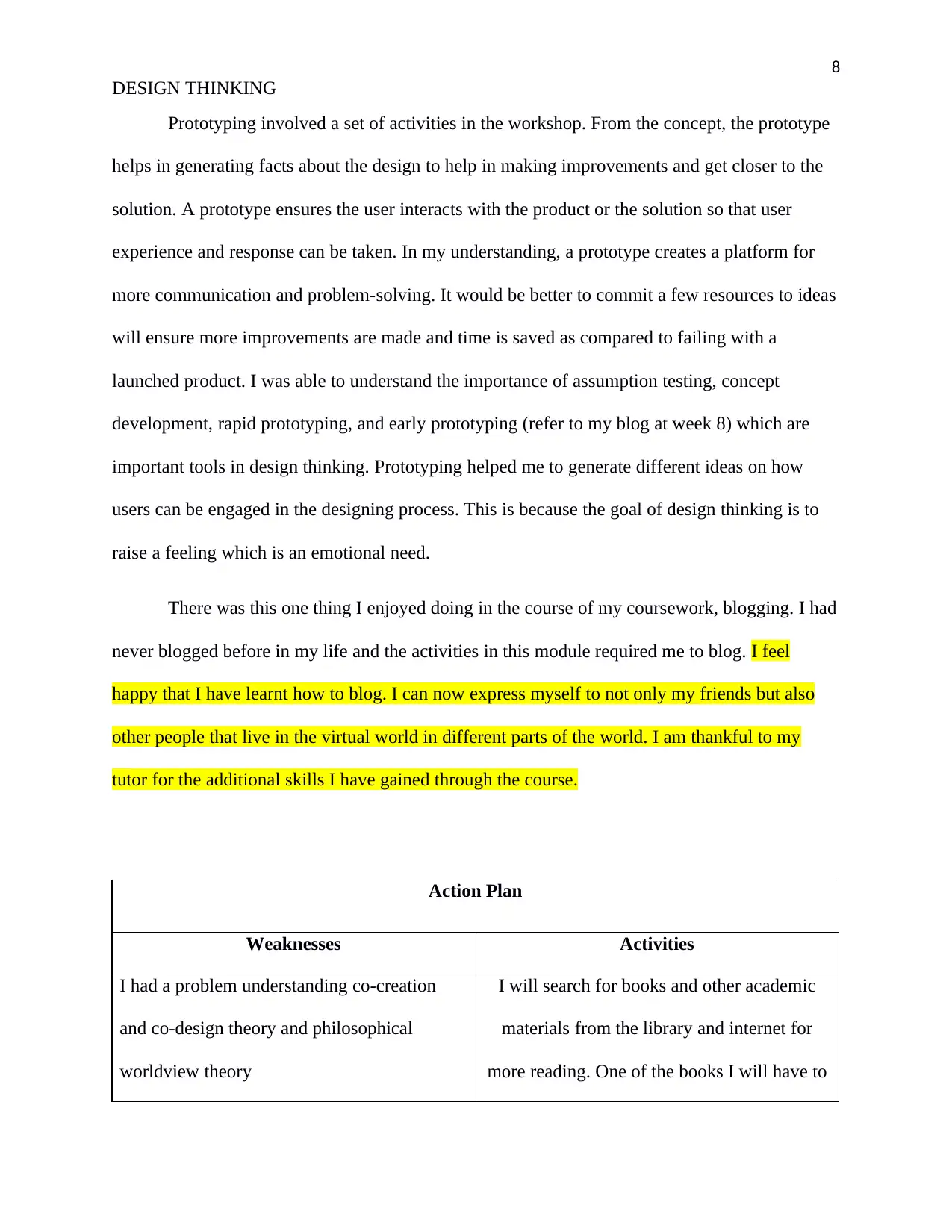
8
DESIGN THINKING
Prototyping involved a set of activities in the workshop. From the concept, the prototype
helps in generating facts about the design to help in making improvements and get closer to the
solution. A prototype ensures the user interacts with the product or the solution so that user
experience and response can be taken. In my understanding, a prototype creates a platform for
more communication and problem-solving. It would be better to commit a few resources to ideas
will ensure more improvements are made and time is saved as compared to failing with a
launched product. I was able to understand the importance of assumption testing, concept
development, rapid prototyping, and early prototyping (refer to my blog at week 8) which are
important tools in design thinking. Prototyping helped me to generate different ideas on how
users can be engaged in the designing process. This is because the goal of design thinking is to
raise a feeling which is an emotional need.
There was this one thing I enjoyed doing in the course of my coursework, blogging. I had
never blogged before in my life and the activities in this module required me to blog. I feel
happy that I have learnt how to blog. I can now express myself to not only my friends but also
other people that live in the virtual world in different parts of the world. I am thankful to my
tutor for the additional skills I have gained through the course.
Action Plan
Weaknesses Activities
I had a problem understanding co-creation
and co-design theory and philosophical
worldview theory
I will search for books and other academic
materials from the library and internet for
more reading. One of the books I will have to
DESIGN THINKING
Prototyping involved a set of activities in the workshop. From the concept, the prototype
helps in generating facts about the design to help in making improvements and get closer to the
solution. A prototype ensures the user interacts with the product or the solution so that user
experience and response can be taken. In my understanding, a prototype creates a platform for
more communication and problem-solving. It would be better to commit a few resources to ideas
will ensure more improvements are made and time is saved as compared to failing with a
launched product. I was able to understand the importance of assumption testing, concept
development, rapid prototyping, and early prototyping (refer to my blog at week 8) which are
important tools in design thinking. Prototyping helped me to generate different ideas on how
users can be engaged in the designing process. This is because the goal of design thinking is to
raise a feeling which is an emotional need.
There was this one thing I enjoyed doing in the course of my coursework, blogging. I had
never blogged before in my life and the activities in this module required me to blog. I feel
happy that I have learnt how to blog. I can now express myself to not only my friends but also
other people that live in the virtual world in different parts of the world. I am thankful to my
tutor for the additional skills I have gained through the course.
Action Plan
Weaknesses Activities
I had a problem understanding co-creation
and co-design theory and philosophical
worldview theory
I will search for books and other academic
materials from the library and internet for
more reading. One of the books I will have to
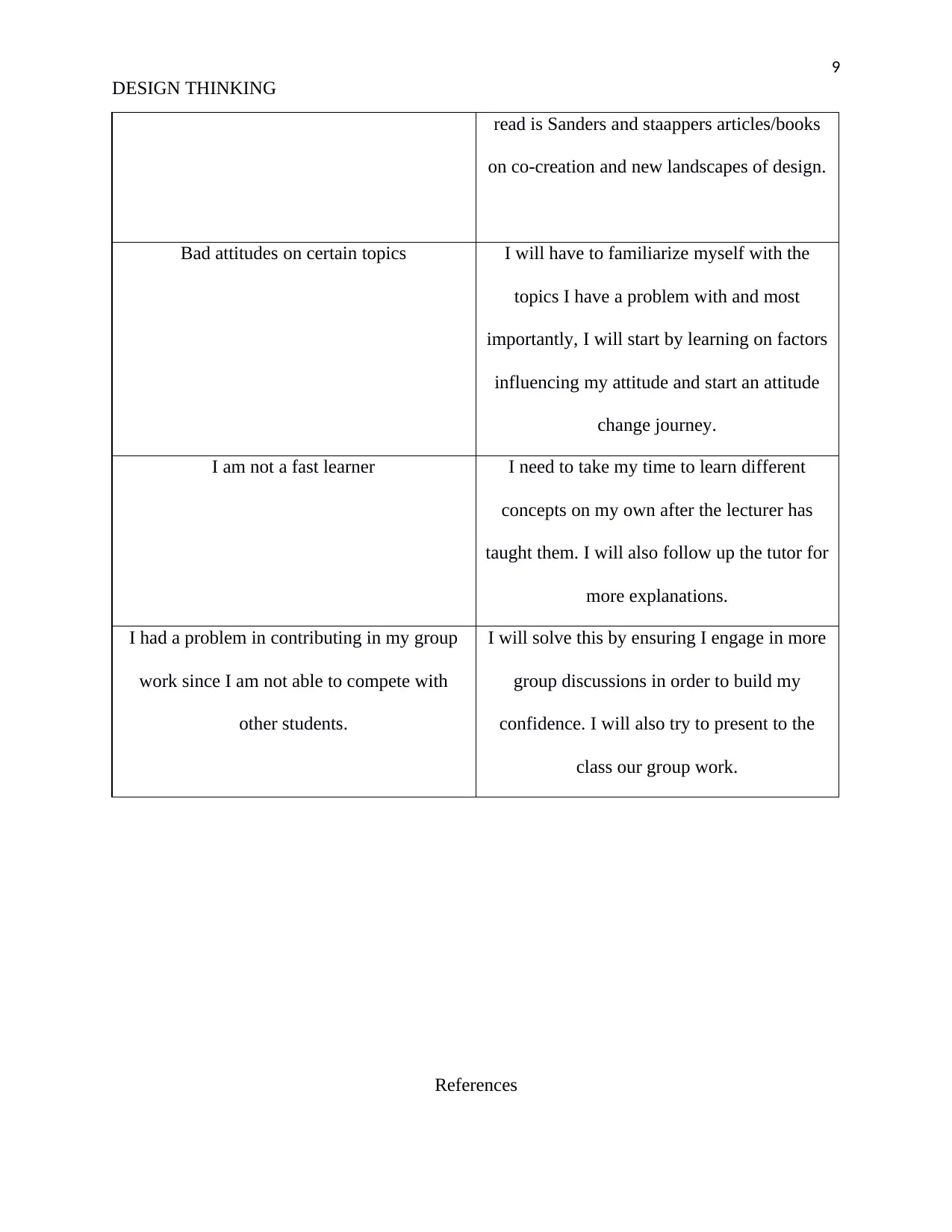
9
DESIGN THINKING
read is Sanders and staappers articles/books
on co-creation and new landscapes of design.
Bad attitudes on certain topics I will have to familiarize myself with the
topics I have a problem with and most
importantly, I will start by learning on factors
influencing my attitude and start an attitude
change journey.
I am not a fast learner I need to take my time to learn different
concepts on my own after the lecturer has
taught them. I will also follow up the tutor for
more explanations.
I had a problem in contributing in my group
work since I am not able to compete with
other students.
I will solve this by ensuring I engage in more
group discussions in order to build my
confidence. I will also try to present to the
class our group work.
References
DESIGN THINKING
read is Sanders and staappers articles/books
on co-creation and new landscapes of design.
Bad attitudes on certain topics I will have to familiarize myself with the
topics I have a problem with and most
importantly, I will start by learning on factors
influencing my attitude and start an attitude
change journey.
I am not a fast learner I need to take my time to learn different
concepts on my own after the lecturer has
taught them. I will also follow up the tutor for
more explanations.
I had a problem in contributing in my group
work since I am not able to compete with
other students.
I will solve this by ensuring I engage in more
group discussions in order to build my
confidence. I will also try to present to the
class our group work.
References
⊘ This is a preview!⊘
Do you want full access?
Subscribe today to unlock all pages.

Trusted by 1+ million students worldwide
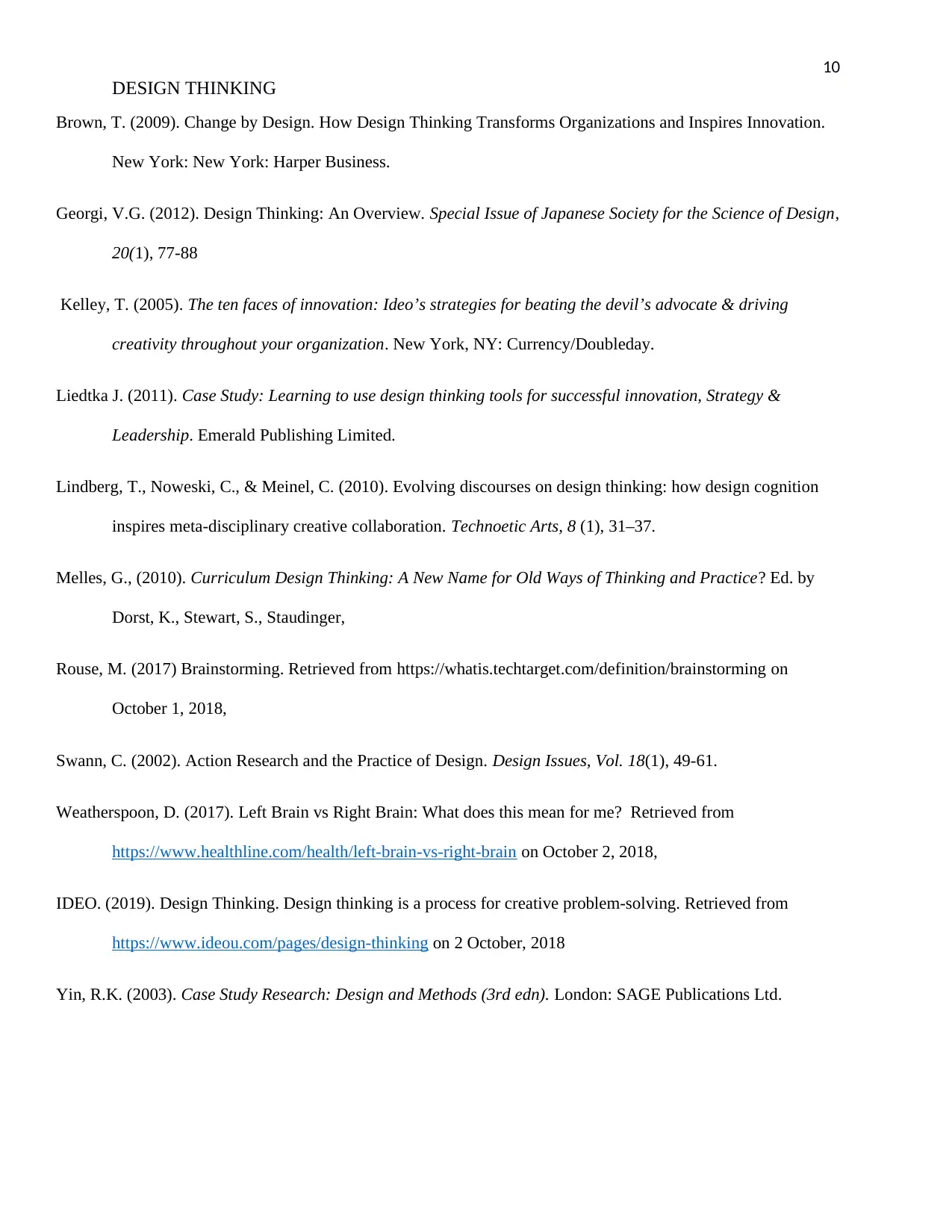
10
DESIGN THINKING
Brown, T. (2009). Change by Design. How Design Thinking Transforms Organizations and Inspires Innovation.
New York: New York: Harper Business.
Georgi, V.G. (2012). Design Thinking: An Overview. Special Issue of Japanese Society for the Science of Design,
20(1), 77-88
Kelley, T. (2005). The ten faces of innovation: Ideo’s strategies for beating the devil’s advocate & driving
creativity throughout your organization. New York, NY: Currency/Doubleday.
Liedtka J. (2011). Case Study: Learning to use design thinking tools for successful innovation, Strategy &
Leadership. Emerald Publishing Limited.
Lindberg, T., Noweski, C., & Meinel, C. (2010). Evolving discourses on design thinking: how design cognition
inspires meta-disciplinary creative collaboration. Technoetic Arts, 8 (1), 31–37.
Melles, G., (2010). Curriculum Design Thinking: A New Name for Old Ways of Thinking and Practice? Ed. by
Dorst, K., Stewart, S., Staudinger,
Rouse, M. (2017) Brainstorming. Retrieved from https://whatis.techtarget.com/definition/brainstorming on
October 1, 2018,
Swann, C. (2002). Action Research and the Practice of Design. Design Issues, Vol. 18(1), 49-61.
Weatherspoon, D. (2017). Left Brain vs Right Brain: What does this mean for me? Retrieved from
https://www.healthline.com/health/left-brain-vs-right-brain on October 2, 2018,
IDEO. (2019). Design Thinking. Design thinking is a process for creative problem-solving. Retrieved from
https://www.ideou.com/pages/design-thinking on 2 October, 2018
Yin, R.K. (2003). Case Study Research: Design and Methods (3rd edn). London: SAGE Publications Ltd.
DESIGN THINKING
Brown, T. (2009). Change by Design. How Design Thinking Transforms Organizations and Inspires Innovation.
New York: New York: Harper Business.
Georgi, V.G. (2012). Design Thinking: An Overview. Special Issue of Japanese Society for the Science of Design,
20(1), 77-88
Kelley, T. (2005). The ten faces of innovation: Ideo’s strategies for beating the devil’s advocate & driving
creativity throughout your organization. New York, NY: Currency/Doubleday.
Liedtka J. (2011). Case Study: Learning to use design thinking tools for successful innovation, Strategy &
Leadership. Emerald Publishing Limited.
Lindberg, T., Noweski, C., & Meinel, C. (2010). Evolving discourses on design thinking: how design cognition
inspires meta-disciplinary creative collaboration. Technoetic Arts, 8 (1), 31–37.
Melles, G., (2010). Curriculum Design Thinking: A New Name for Old Ways of Thinking and Practice? Ed. by
Dorst, K., Stewart, S., Staudinger,
Rouse, M. (2017) Brainstorming. Retrieved from https://whatis.techtarget.com/definition/brainstorming on
October 1, 2018,
Swann, C. (2002). Action Research and the Practice of Design. Design Issues, Vol. 18(1), 49-61.
Weatherspoon, D. (2017). Left Brain vs Right Brain: What does this mean for me? Retrieved from
https://www.healthline.com/health/left-brain-vs-right-brain on October 2, 2018,
IDEO. (2019). Design Thinking. Design thinking is a process for creative problem-solving. Retrieved from
https://www.ideou.com/pages/design-thinking on 2 October, 2018
Yin, R.K. (2003). Case Study Research: Design and Methods (3rd edn). London: SAGE Publications Ltd.
1 out of 10
Related Documents
Your All-in-One AI-Powered Toolkit for Academic Success.
+13062052269
info@desklib.com
Available 24*7 on WhatsApp / Email
![[object Object]](/_next/static/media/star-bottom.7253800d.svg)
Unlock your academic potential
Copyright © 2020–2025 A2Z Services. All Rights Reserved. Developed and managed by ZUCOL.




